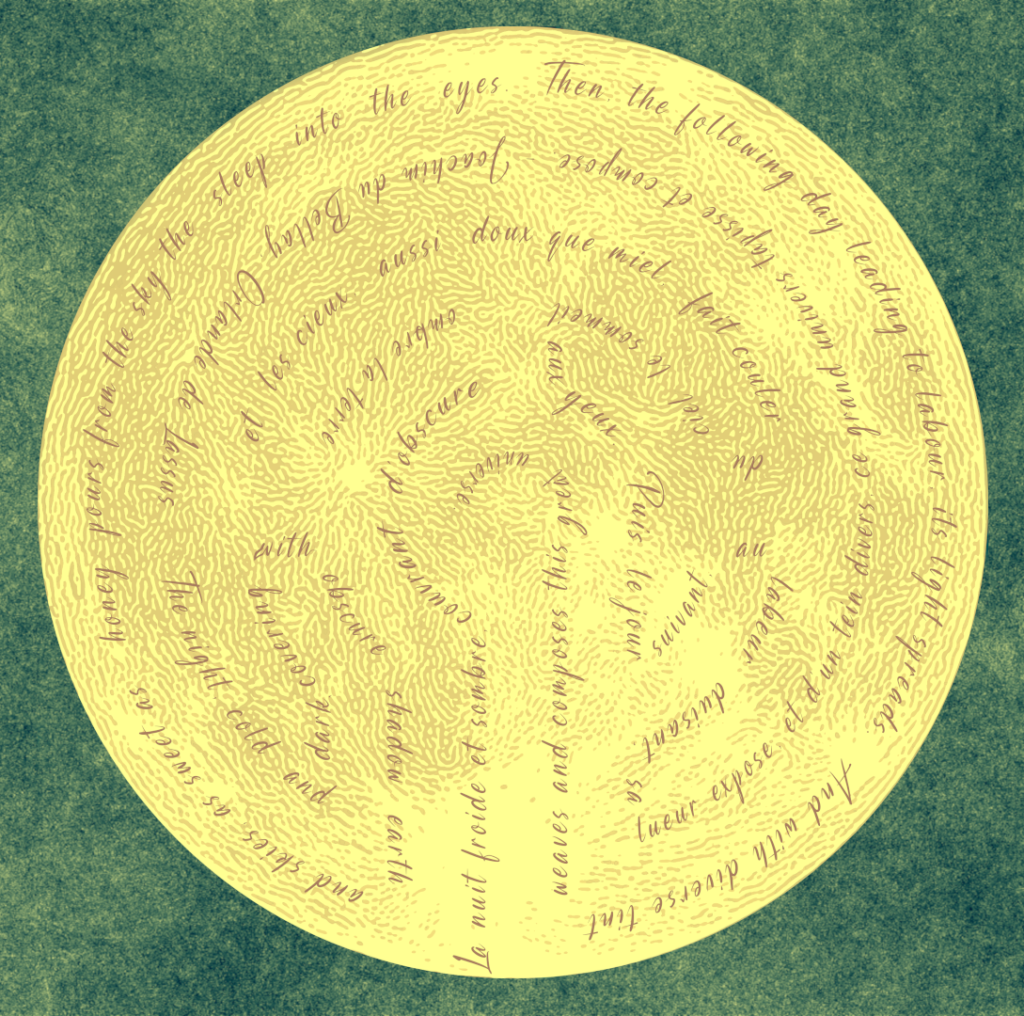We’re still working on the blog entry we promised about the piece What Is Our Life, but we had to move the website to a different host and are slowly reworking some areas of it. For now, it’s Christmastime, or for those not into holidays, it’s just after the solstice — that’s the winter solstice in the Northern Hemisphere, when the night has been long but the light starts to grow. So, we’ve published a video on YouTube that might somewhat fit the spirit of the occasion even though it’s not obviously Christmassy. Since it celebrates the far-reaching effects of a new day, by extension it suggests both the winter solstice and the promise of a new year as well.
La nuict froide et sombre
Youtube: https://www.youtube.com/watch?v=n2vzua5Urlo
Music by Orlande de Lassus (also Orlando di Lasso and other variations)
Text by Joachim du Bellay
Published in 1576
Played on viola da gamba and edited (audio/video) by Eszter Komáromi
Text and translation
La nuict froide et sombre,
couvrant d’obscure ombre
la terre et les cieux,
aussi doux que miel,
fait couler du ciel
le sommeil aux yeux.
Puis le jour luisant,
au labeur duisant,
sa lueur expose,
et d’un tein divers,
ce grand univers
tapisse et compose.
Joachim du Bellay
The night, cold and dark,
covering with obscure shadow
earth and skies,
as sweet as honey
pours from the sky
the sleep into the eyes.
Then, the gleaming day
leading to labour,
its light spreads.
And with diverse tint
drapes and composes
this great universe.
Translation submitted to CPDL by: Mark Wenzel, Frederick Perez
Making of

Eszter started this video both to learn about AI tools and as a personal experiment. She says:
“The piece was in my mind as my version of optimism. Although it starts in the dark, I had used it at the end of my programme on melancholy to provide an acceptably optimistic end for both those immersed in melancholy and those looking for something, well, lighter.”
About the process of generating usable images in AI, Eszter says: “The plan was to use the lines of the poems as prompts, using the final image of one process as the starting image of the next. It involved a lot of experimenting, and also looking at others’ creations. Constructing useful prompts for the AI is an art onto itself … when I spotted results that looked good, I found they came from extremely complex prompts and I still don’t fully understand how to create them. So, it’s easy to get random fun/cool results, but not straightforward to get what you want (I did end up ‘cheating’ here and there by, for example, creating and combining multiple versions of the same text). My thoughts went something like this: Oh, a lot depends on the starting image … let’s try a lot of starting images … oh, a labyrinth would be a good thematic fit … hooray, good visual result, it looks like the moon exploding into a landscape … cool, use a moon image as the basis of the labyrinth … could I add the text of the piece to it? Sure … etc.”
The source of our labyrinth image says ‘Reims’, but the actual Reims labyrinth (in the Reims Cathedral in the French city of the same name) is much larger and not round, though it could be an extension of the same pattern. The Moon image is from its Wikipedia article and the AI image/video generation is by NightCafe.
Other notes
Seasonal connections
The piece, a French chanson, is a good seasonal fit because of the dark to light progression, as in both the winter solstice and not entirely independently the Christian concept of the birth of Christ bringing light to the world. The labyrinth is also a good tie-in because of its spiritual and religious associations, historically and in the present. Mazes/labryinths were present in various ancient cultures and much used in medieval Christianity, although the exact manner of their use is not immediately that clear. We have come across interpretations of the labyrinth such as its symbolising the pilgrimage to the Holy Land or a journey towards Christ and so on. The terms ‘labyrinth’ and ‘maze’ are somewhat interchangeable, but a maze has multiple ways out and one can get lost in it whereas a labyrinth has only one clear way to the middle, the centre of focus. It can also be an immersion in oneself or an introspective journey. Eszter adds: “As the text of the piece says, we’re in a grand universe, complex and wonderful, so that’s where I would want to go as a spiritual journey, through the cold dark night into that universe.”
Composer
Orlande de Lassus (various other names; probably c. 1532 – 14 June 1594). Variations of his name include Roland de Lassus, Orlando di Lasso, Orlandus Lassus, Orlande de Lattre and Roland de Lattre, depending on where his music was published or performed. He was a major Franco-Flemish composer of the late Renaissance, born in a part of the Hapsburg Empire that is now Belgium. He travelled a lot but ended up living mostly in Munich – which we appreciate, since we are always looking for travel and multicultural influences in our material! He wrote a very large variety of works and was famous and extremely popular even beyond musical circles: he was given nobility (which was rare for a composer) and knighted. The piece was published in 1576 but we don’t know much about the circumstances of his writing it.
Poet
Joachim du Bellay (c. 1522 – 1 January 1560) – born just about 500 years ago! In his studies, he came in contact with humanists and poets and became a notable element in the start of the French school of Renaissance poetry, which sometimes turned quite political in both its battles among groups of poets and its encouragement of French political debate with the aim of reforming the country. Du Bellay modeled some of his poetry after Petrarch and other Italian poets and encouraged the influence of Latin (even more than Greek), but strove to develop French into its own medium for high forms of poetry. He helped make the sonnet form popular in French poetry, and some of his work was translated into Spanish and, by the great English poet Edmund Spenser, into English.
